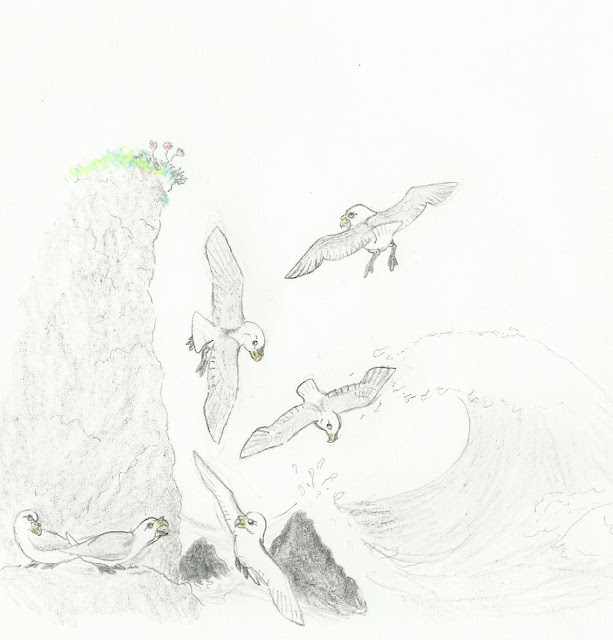Fulmar (Fulmarus glacialis)
At first glance, the fulmar appears to be a gull. It’s wide
grey wings, white body and yellow bill and general behaviour are certainly very
similar, but it is a tube-nose, related to shearwaters, petrels and the famous
albatross. On closer inspection the fulmar glides on stiff, straight wings with
occasional rapid wing-beats, unlike the graceful tapering, swooping wings of a
gull, and has a charmingly dumpy body, round head and stubby bill. And of course,
the bill has a tube nostril, which excretes salt from its diet and the seawater
it drinks. Like gulls, fulmars also have
a ‘furrowed brow’ look, which helps protect their eyes from the sea’s
reflective glare.
The fulmars name is a corruption of the Norse ‘Foul Maa’
meaning foul gull1, from their infamous defence strategy of projectile
vomiting fish oil onto their attacker,
apparently up to five feet away! Unsurprisingly, this sticky, smelly defence is
an effective deterrent against any predator with a sense of smell or
cleanliness. If you really want to see
it in more detail, go here.
Unbelievably, the people of St Kilda island, Scotland, once used ‘fulmar oil’
as a medicine2!
For good or for bad, fulmars are full of character. Once, at
pendennis castle, Cornwall, I witnessed their excellent flying abilities as a
pair were gliding backwards and forwards on the wind next to the ruins. At the last second they would switch direction or push off with
their feet, narrowly avoiding being dashed against the stones. Whether it was for pure joy or flying
practice, it certainly looked like they were having fun! I witnessed this again with friends on the
cliffs of the Pembrokeshire coast, and we almost suffered a fulmar to the face
as we watched from the ledge.
On a very different side to their character, the fulmar is surprisingly high in the pecking order for its size, possibly due to it’s defense. On a sea fishing trip being trailed by a fulmar and several gulls, even the great black backed gull gave way to the fulmar when offal was thrown overboard, despite the gull being almost twice the fulmar’s weight. They have also been photographed fighting off skuas for food.
Asides from oily fish fulmars also feed on squid, crustaceans and carrion, either from the surface or by diving to a depth of 3 meters in the open sea3. Hence they are mainly pelagic (open ocean) birds though they may be found along the coast most of the year. They are not fussy nesters, favouring cliffs but also using burrows, walls, roofs and even open ground, sometimes a little inland from the coast. Here they will raise just a single chick in a bare nest. This breeding strategy pays off as fulmars are one of the longest-living birds, reaching 30-50 years, though they only start breeding at around 10 years old3.
On a very different side to their character, the fulmar is surprisingly high in the pecking order for its size, possibly due to it’s defense. On a sea fishing trip being trailed by a fulmar and several gulls, even the great black backed gull gave way to the fulmar when offal was thrown overboard, despite the gull being almost twice the fulmar’s weight. They have also been photographed fighting off skuas for food.
Asides from oily fish fulmars also feed on squid, crustaceans and carrion, either from the surface or by diving to a depth of 3 meters in the open sea3. Hence they are mainly pelagic (open ocean) birds though they may be found along the coast most of the year. They are not fussy nesters, favouring cliffs but also using burrows, walls, roofs and even open ground, sometimes a little inland from the coast. Here they will raise just a single chick in a bare nest. This breeding strategy pays off as fulmars are one of the longest-living birds, reaching 30-50 years, though they only start breeding at around 10 years old3.
The fulmar has an interesting history in Britain. In 1870,
the only British breeding fulmars were on the remote North-west Scottish
islands of St Kilda. Here they were a staple food for the islanders. By the
1970’s they were breeding over almost the entire British coastline 1,3,4!
Oddly enough, this wasn’t a spread of st Kildan birds, but a
population explosion of the more adaptable Icelandic fulmars. Increased food
resources from fishing vessels and whaling is likely a major cause of this
spread, but the warming of the North-East Atlantic and even genetics have been
suggested as other factors. So next time you’re holidaying on the coast, look
out for this pugnacious yet playful bird among the gulls.

No comments:
Post a Comment